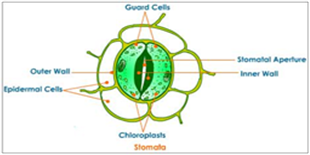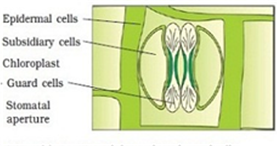 Long Answer Type
Long Answer TypeExplain the process of secondary growth in the stems of woody angiosperms with the help of schematic diagrams. What is its significance?
Draw illustrations to bring out anatomical difference between:
(a) Monocot root and dicot root
(b) Monocot stem and dicot stem
Cut a transverse section of young stem of a plant from your school garden and observe it under the microscope. How would you ascertain whether it is a monocot stem or a dicot stem? Give reasons.
 Short Answer Type
Short Answer TypeThe transverse section of a plant material shows the following anatomical features:
(a) the vascular bundles are conjoint, scattered and surrounded by a sclerenchymatous bundle sheaths.
(b) phloem parenchyma is absent. What will you identify it as?
 Long Answer Type
Long Answer TypeWhat is stomatal apparatus? Explain the structure of stomata with a labelled diagram.
Stomata are small pores present in the epiderms of leaves.
The stomatal aperture, guard cells and the subsidiary cells together are called the stomatal apparatus.
Structure of stomata: Each stomata is composed of two bean-shaped structure called guard cells. In grasses the guard cell is dumbbell shaped. The inner walls of guard cells are thick, while the outer walls are thin. The guard cells are surrounded by subsidiary cells. These are the specialised epidermal cells present around the guard cells called the subsidiary cells.

 Short Answer Type
Short Answer TypeName the three basic tissue systems in the flowering plants. Give the tissue names under each system.
 Long Answer Type
Long Answer Type